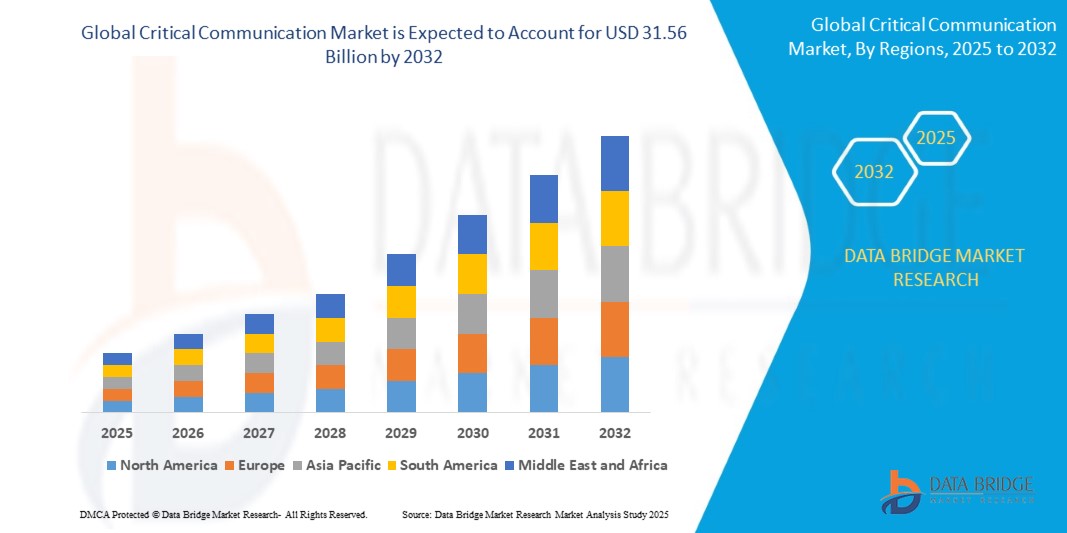Enhancing Connectivity and Safety: The Expanding Landscape of the Critical Communication Market
Global Critical Communication Market Size, Share, and Trends Analysis Report – Industry Overview and Forecast to 2032
- The global critical communication market size was valued at USD 17.96 billion in 2024 and is expected to reach USD 31.56 billion by 2032, at a CAGR of 7.30% during the forecast period
https://www.databridgemarketresearch.com/reports/global-critical-communication-market

In an increasingly interconnected and fast-paced world, seamless and reliable communication has become the cornerstone of public safety, emergency response, defense, and industrial operations. The Critical Communication Market is gaining substantial momentum as organizations and governments prioritize secure, real-time communication solutions that operate efficiently even during crises or infrastructure failures. This market encompasses technologies such as land mobile radio (LMR), long-term evolution (LTE), and next-generation networks that enable mission-critical information exchange, ensuring operational continuity in high-stakes environments.
Market Overview
Critical communication refers to systems and services that ensure uninterrupted information flow during emergencies or critical operations. These communication networks are essential in sectors such as defense, public safety, transportation, energy, manufacturing, and healthcare. Unlike conventional commercial communication systems, critical communication networks are built to deliver high reliability, low latency, data security, and interoperability across various platforms and devices.
The market is witnessing robust growth due to rising concerns about national security, increasing demand for disaster management systems, and the growing integration of advanced digital communication technologies. Governments and enterprises are heavily investing in upgrading their legacy radio systems to modern broadband-based solutions that can support both voice and data communications. The deployment of 5G technology, AI-driven communication platforms, and IoT-based monitoring systems is further expanding the scope of the critical communication ecosystem.
Key Market Drivers
Rising Demand for Public Safety and Emergency Response Systems
One of the most significant drivers of the critical communication market is the increasing need for reliable communication infrastructure among law enforcement agencies, fire departments, and emergency medical services. These agencies require instant communication to coordinate effectively during natural disasters, accidents, or terrorist incidents. The shift from analog to digital communication systems allows real-time data sharing, video transmission, and location tracking, improving overall response efficiency.
Technological Advancements in Communication Infrastructure
The adoption of 4G LTE and 5G networks has revolutionized mission-critical communications by enabling faster, more secure, and data-intensive communication. Modern solutions offer enhanced bandwidth, low latency, and high-speed connectivity, essential for operations like remote monitoring, predictive maintenance, and smart surveillance. These advancements are pushing governments and private organizations to upgrade their existing infrastructure to remain resilient and adaptive in emergencies.
Integration of IoT and AI
The combination of IoT (Internet of Things) and AI (Artificial Intelligence) is transforming the way critical communication networks function. IoT devices such as sensors, drones, and connected cameras can transmit real-time data, while AI algorithms help analyze this information to predict potential risks or system failures. This integration supports faster decision-making and improved situational awareness, particularly in sectors like defense, oil and gas, and public safety.
Government Initiatives and Investments
Many governments are implementing programs and funding initiatives to strengthen communication networks for public safety. For instance, several nations are developing broadband public safety networks to improve coordination between agencies. These initiatives aim to provide secure, high-speed communication channels that can withstand emergencies, cyberattacks, or natural disasters.
Market Challenges
Despite strong growth potential, the critical communication market faces several challenges:
High Implementation Costs:
The installation and maintenance of mission-critical communication systems involve significant investment, especially for hardware, software, and network infrastructure. This can be a barrier for small and medium-sized enterprises or developing nations.
Spectrum Management Issues:
Spectrum availability is a critical issue for communication systems. The allocation of appropriate frequencies for critical communication without interference from commercial networks is often a complex regulatory process.
Cybersecurity Threats:
As communication systems become more digital and interconnected, the risk of cyberattacks also increases. Protecting sensitive data and ensuring network resilience against cyber threats is a top priority for stakeholders.
Interoperability Concerns:
With multiple vendors and legacy systems in use, ensuring interoperability between different communication devices and networks remains a challenge, especially during large-scale emergencies involving multiple agencies.
Market Opportunities
The growing adoption of broadband technology in mission-critical applications is creating new opportunities for industry players. Private LTE and 5G networks are emerging as game-changers, enabling enhanced data communication for industries such as utilities, transportation, and manufacturing. Additionally, the trend toward smart cities and connected infrastructure is boosting demand for reliable and secure communication systems that can manage public safety operations and critical utilities efficiently.
The defense and military sectors are also investing heavily in next-generation communication technologies that ensure real-time connectivity across land, air, and sea operations. Moreover, the healthcare industry is leveraging critical communication systems for remote patient monitoring, telemedicine, and hospital coordination, especially during pandemics or medical emergencies.
Regional Insights
North America:
North America dominates the critical communication market, driven by advanced technological adoption and strong government support for public safety communication systems. The presence of major players and ongoing projects to modernize emergency communication infrastructure further enhance market growth.
Europe:
Europe’s market is growing steadily, supported by increased spending on defense and smart city initiatives. The European Union’s focus on developing interoperable communication systems for cross-border emergency coordination is also contributing to market expansion.
Asia-Pacific:
Asia-Pacific is expected to witness the fastest growth due to rapid urbanization, infrastructure development, and government investments in public safety. Countries like China, Japan, and India are investing in broadband and 5G networks to strengthen their communication capabilities.
Middle East and Africa:
The growing emphasis on national security, disaster management, and modernization of defense communication systems is fueling market growth in this region. The rise in oil and gas operations also contributes to the demand for reliable communication solutions.
Competitive Landscape
The critical communication market is highly competitive, with key players focusing on innovation, partnerships, and technology upgrades. Companies are investing in AI-based communication systems, cloud-enabled solutions, and secure data transmission technologies to gain a competitive edge. The market includes leading firms specializing in telecommunications, public safety systems, and digital infrastructure solutions.
Future Outlook
Looking ahead, the critical communication market is poised for significant transformation. The integration of AI, IoT, and 5G will redefine communication capabilities, making networks faster, smarter, and more resilient. Governments and enterprises will continue to prioritize secure, uninterrupted communication systems to safeguard lives and maintain operational stability.
Browse More Details :
Global Antihistamine Drugs Market
Global Bike Tyre Market
Global Bullet Proof Jacket Market
Global Coherent Optical Equipment Market
Global Complementary and Alternative Medicine Market
Global Critical Communication Market
Global Educational Robot Market
Global Kitchen Sinks Market
Global People Counting System Market
Global Premium Spirits Market
Global Pretzels Market
Global Shoe Insole Market
Global Smartwatch Market
Global Sports Graphics Market
Global Sports Technology Market



